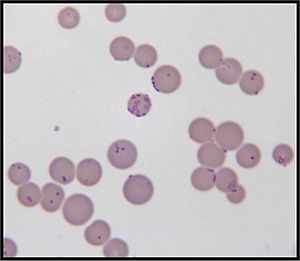Mycoplasmosis facts for kids
Quick facts for kids Mycoplasma |
|
|---|---|
 |
|
| Mycoplasma haemofelis | |
| Scientific classification | |
| Kingdom: | |
| Phylum: | |
| Class: | |
| Order: |
Mycoplasmatales
|
| Family: |
Mycoplasmataceae
|
| Genus: |
Mycoplasma
Nowak 1929
|
| Species | |
|
over 100 species |
|
Mycoplasma is a special type of bacteria. Unlike most bacteria, they do not have a strong cell wall around their cell membrane. This makes them very flexible.
They are the smallest known bacterial cells. They are tiny, usually about 0.1 µm (micrometers) across. To give you an idea, a human hair is about 50 to 100 micrometers thick!
Because they lack a cell wall, many common antibiotics like penicillin do not work against them. These antibiotics usually target and destroy the cell wall. Mycoplasma also need special fats called sterols, like cholesterol, to grow.
Many Mycoplasma species live as parasites. This means they live on or inside other living things, like humans or animals. They can cause sickness. Some can even survive without oxygen.
Contents
What are Mycoplasma?
Mycoplasma are unique bacteria. They are part of a group called Mollicutes. This group is known for not having a cell wall.
Imagine a balloon without a strong outer shell. That's a bit like Mycoplasma. This lack of a wall helps them squeeze into tiny spaces. It also makes them hard to fight with some medicines.
They are so small that you need a powerful microscope to see them. Their tiny size helps them hide and spread easily.
How Mycoplasma Affect Living Things
Many Mycoplasma species are pathogens. This means they can cause diseases in humans and animals. They often live in the body without causing problems at first. But sometimes, they can lead to serious health issues.
For example, Mycoplasma pneumoniae is a common cause of pneumonia. Pneumonia is an infection of the lungs. It can make breathing difficult. This type of Mycoplasma spreads through tiny droplets when someone coughs or sneezes.
Other types of Mycoplasma can affect different parts of the body. They can cause infections in the urinary tract or joints. In animals, they can cause diseases in livestock and pets.
Why are Mycoplasma Hard to Treat?
Treating Mycoplasma infections can be tricky. This is mainly because they do not have a cell wall. Most common antibiotics, like penicillin, work by attacking the cell wall of bacteria.
Since Mycoplasma don't have this wall, these antibiotics are useless against them. Doctors must use different types of antibiotics. These special antibiotics target other parts of the Mycoplasma cell.
It's important to get the right diagnosis. This helps doctors choose the correct medicine.
Discovering Mycoplasma
The genus Mycoplasma was first named by Julian Nowak in 1929. Scientists have been studying these tiny bacteria for a long time. They want to understand how they cause disease. They also want to find better ways to treat the infections.
There are over 100 different species of Mycoplasma. Each species can behave differently. Some are harmless, but many can cause health problems.
See also
 In Spanish: Micoplasma para niños
In Spanish: Micoplasma para niños

